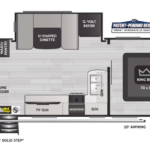Towing safety has improved dramatically in the last 75 years. Before the 1950s, the role of slowing down a trailer or towed vehicle fell on the towing vehicle until the Kelsey Hayes Company invented the first trailer brake controller (though early designs were mostly hydraulic as opposed to the electric designs we see on most modern towable RVs).
Since then, towing safety innovation has continued, and this component is largely responsible. Here’s everything you need to know about trailer braking systems.
Key Takeaways
- Purpose & Function: A trailer brake controller is an electronic device that synchronizes the braking of a tow vehicle and its trailer, ensuring safer, controlled stops.
- Types & Adjustments: There are two main types—proportional and time-delayed—each offering different braking responses.
- Installation & Safety: Proper installation is crucial, often requiring a vehicle-specific brake wiring harness. To ensure safety and compatibility, a trained RV technician should install it.
What Is a Trailer Brake Controller?

A trailer brake controller is an electronic device that controls the braking system on your towable RV. When you apply the brakes in your tow vehicle, the controller sends a signal to activate the trailer brakes.
Most designs include an interface in the tow vehicle‘s cockpit. This interface allows you to control the gain setting, which is defined as the amount of power applied to the trailer brakes.
Do I Need a Trailer Brake Controller?
Federal law requires trailers with a loaded weight exceeding 3,000 pounds to have a braking system. This system requires a trailer brake controller to operate the trailer’s brakes effectively. Beyond loaded weight, any trailer with electric or electro-hydraulic brakes requires a trailer brake controller.
Fortunately, many trucks are manufactured with brake controls. If you’re towing with an SUV, minivan, or compact truck, there’s a higher chance you’ll need an aftermarket control for your trailer’s braking system.
Do Trailer Brakes Work Without a Controller?
Without a controller, there’s no way for your tow vehicle to operate the trailer brakes. In essence, you can apply the brakes in your tow vehicle, but there’s no signal telling the trailer brakes to apply equal braking force to slow you down.
There is one possible exception to this rule. Most RV trailers are equipped with an emergency breakaway cable that will effectively trigger the application of trailer brakes if it is disconnected. This cable is clipped to an anchor point on your tow vehicle, usually somewhere on the hitch receiver. If it is pulled from its anchor point on the trailer, the trailer brakes will be applied.
How Does a Trailer Brake Controller Work?
There are two main types of electronic brake controllers for trailer towing: proportional and time-delayed.
Proportional trailer brake controllers apply force to your trailer’s brakes proportional to the amount of force being applied to your tow vehicle’s brakes. The harder you brake, the more force the controller applies to your trailer’s brakes. Newer controllers utilize an accelerometer to detect deceleration and apply the appropriate amount of brake force.
Time-delayed trailer brake controllers allow you to select a gain setting that tells the controller the amount of braking force to apply. Once set, this force will be applied whether you’re coming to a slow stop or braking abruptly. This can cause jerky stops and push-pull between your trailer and tow vehicle, but you can adjust the gain setting in transit.
How To Use a Trailer Brake Control

Every manufactured model operates slightly differently, making your owner’s manual the best resource to learn how to operate a trailer brake control. However, most models require the following steps to set them up and begin using them:
- Set up the controller and choose your personal settings.
- Adjust the brake gain setting.
- Adjust braking sensitivity.
- Manually activate the trailer brakes as needed.
Once you’ve installed your trailer brake controller and chosen your settings, using it is simply a matter of driving your RV safely. If you have a time-delayed model, you may need to adjust settings occasionally, but using a brake control requires minimal additional effort after the initial installation.
How To Install a Trailer Brake Controller
Brake controllers are a critical hitch and tow accessory. They ensure your stopping power when towing and the safety of your RV road trips rely heavily on this device. For those reasons, we highly recommend trusting the installation of this braking safety device to a trained RV technician.
That said, here are the basic steps to install most trailer brake controllers. Remember, the process varies based on the device’s manufacturer.
- Disconnect your tow vehicle’s negative battery cable.
- Choose where to mount the controller’s interface.
- Carefully drill holes into the dash for the mounting bracket.
- Mount the interface bracket and secure the interface.
- Connect the interface using a vehicle-specific wiring harness.
Here are a few safety tips to remember for this installation:
- Disconnecting your battery helps to prevent personal injury and/or damage to your vehicle’s electronics, including the new brake controller you’re installing.
- Avoid installing a brake controller next to sensitive electronics like a CB radio or RF transmitter.
- Mark the mounting location before you drill. Be extremely careful when selecting the drilling location. Remove the panel and drill holes for the mounting bracket outside your vehicle to avoid costly damage.
- Take care not to overtighten the screws when installing the mounting bracket.
- The location of the factory wiring harness varies. Consult your vehicle’s owner’s manual to find the location of yours.
- Check the space behind the dash to ensure that no wiring or components will be in the path of the drill bit.
Looking for brake controller installation near you?
How To Adjust Trailer Brake Output

To adjust a trailer brake controller, your tow vehicle must be hooked up to your towable, and the wiring harness must be plugged in. Park on a level surface and ensure you have a safe area with plenty of stopping distance ahead. Then, follow these steps:
Calibrate
Luckily, most trailer brake controllers calibrate automatically, and some don’t even require calibration. With self-calibrating brake controllers, wait for the interface’s flashing light or signal stating calibration is complete. Consult the owner’s manual for the appropriate light or signal to look for.
Select Settings
Some interfaces offer various personal settings. These include, but are not limited to, the brightness and viewing angle of the interface. Choose your settings before moving on.
Adjust Maximum Braking Output
Maximum output is the upper threshold for the force the controller will apply to your trailer’s brakes. Adjust this setting according to the size of the load you’re towing. To start, depress the brake pedal and adjust the output setting according to the manufacturer’s setup instructions.
Then, test the output by accelerating in a safe, open area to about 25 miles per hour (mph) and applying the brakes. If you’re stopping too slowly, increase the maximum output setting. If you’re stopping too suddenly, decrease it. This is otherwise known as gain adjustment.
Adjust Braking Sensitivity
Your brake controller’s sensitivity setting controls how aggressively the interface applies your trailer brakes. Most models allow you to adjust this setting using the same method used to adjust braking output.
Set the sensitivity to the manufacturer’s initial setup recommendation. Then, accelerate up to 25 mph and apply your tow vehicle’s brakes. If you stop too quickly, reduce the sensitivity setting. If the interface feels too slow to respond, increase the setting.
Technician Tip: Braking will feel mushy or delayed when set too low and jerky when set too high.
As you become more comfortable with your trailer brake controller, conduct this test at varying speeds to dial in your preferred settings and ensure the smoothest possible stopping in all driving conditions.
Where To Find a Trailer Brake Controller
Ensuring compatibility is important for safe towing. Your brake control system must fit your tow vehicle’s electrical connector and be rated for the number of axles in your towing setup—typically one, two, or three, depending on the size of your RV.
Other shopping factors include, but aren’t limited to, braking system output, length of power cord, and installation requirements. Retail specialists at your local Camping World are an excellent resource for helping you find the best brake control for your trailer.
Safety is critical when pulling a towable RV or towing a vehicle behind a motorhome. Here are a few more resources to help you tow safely:
- How To Safely Load a Travel Trailer
- Must Have RV Tools
- How To Pack a Toy Hauler with Flammables Safely
Do you have any questions about trailer brake controllers? Let us know in the comments below.
The post What Is a Trailer Brake Controller? appeared first on Camping World Blog.


